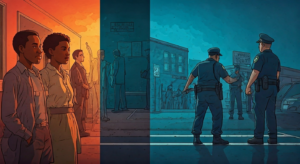Special Report Drug Combat: Insider Strategies Unveiled
Special Report: Drug Combat Strategies Revealed

Key Highlights
- Drug trafficking and abuse present a significant challenge to the United States and the world.
- The opioid crisis continues, with fentanyl and newly emerging synthetic opioids like nitazenes posing serious threats.
- Cartels in Mexico and Colombia play a key role in the global drug trade.
- Law enforcement agencies, including the DEA and FBI, employ various measures to combat drug trafficking.
- Community-based prevention programs and international cooperation are crucial for addressing the multi-faceted drug problem.
- Public participation in prevention programs is essential for creating safer and healthier communities.
Introduction
Drug trafficking is still a major problem for the United States. It requires strong action from law enforcement across the country. This illegal trade causes violence, addiction, and other serious issues in society. To handle these challenges, we need a variety of strategies. This report looks at the current situation of drug trafficking in the US. It also covers the plans in place to fight against this widespread problem. We need to work on stopping the supply and reducing the demand through prevention and treatment.
The Current State of Drug Trafficking in the United States

The United States is dealing with a changing drug trafficking problem. Illicit drugs keep crossing its borders. Even with efforts to stop this illegal trade, organized criminal groups find ways to take advantage of weak spots. This makes it hard for law enforcement to keep control.
The opioid crisis, driven by fentanyl and other strong synthetic opioids, is still a major public health issue. New synthetic opioids like nitazenes make the problem even harder. This emphasizes the need for new ideas and methods to fight this serious epidemic.
Overview of Major Drug Types and Their Distribution Channels
Fentanyl is a powerful synthetic opioid that is much stronger than heroin. It is the main drug in the illegal opioid market. This causes more overdose deaths in our country. Fentanyl is cheap and easy to make. That’s why traffickers like to sell it. They often mix it with other drugs without telling the users.
Heroin is still a big issue, even though fentanyl is more prominent now. It is especially a problem in some areas. Heroin is very addictive and its harmful effects still put people and communities at risk. These areas are already dealing with the opioid crisis.
Cannabis is the most used illegal drug in the world and has a big part in the US drug market too. Some states allow its use for fun or medicine. But it’s still produced and sold illegally, which makes a lot of money for criminal groups.
Key Players in the Drug Trafficking World
Cartels, mainly from Mexico and Colombia, have a lot of power in the global drug trade. They control large networks for making, moving, and selling drugs. Their complex operations and violent tactics make it hard for law enforcement agencies around the world to fight them.
Mexican cartels, often linked to the CIA, are known for their violence and their control over important drug routes into the United States. They still lead the markets for heroin, methamphetamine, and fentanyl. Their reach goes deep into the US, helped by complicated networks and corrupt officials.
Colombian cartels used to be in charge of the cocaine trade. Now, they have changed to fit new trends in the drug market, which includes operations linked to Miami. They are getting involved in other illegal activities and working with Mexican cartels to grow their influence.
Impact of Drug Abuse on Society
Drug abuse has a serious impact on American society. It affects people who are addicted, along with their families and communities. It also puts a strain on the healthcare and criminal justice systems. The effects of this issue can be seen in many areas of life in America. This situation needs a caring and thorough approach to make it better.
Aside from the huge human cost, drug abuse also hurts the economy. It places pressure on healthcare services, lowers work productivity, and challenges social services. To tackle this complex issue, we need a team effort. This means working together in prevention, treatment, and law enforcement efforts.
Health Consequences of Long-term Drug Use
Long-term drug use can result in serious health issues. These problems can include chronic diseases and mental health disorders. There is also a higher risk of overdose. The CDC says that drug overdoses are one of the top causes of injury-related death in the US. This shows how important it is to find better public health solutions.
Using drugs for a long time can cause heart diseases, strokes, cancer, HIV/AIDS, hepatitis, and breathing issues. On the mental health side, it often leads to problems like depression, anxiety, paranoia, and psychosis. These issues can make life even harder for those facing addiction.
The serious health effects of drug abuse affect not only individuals but also families, communities, and the entire healthcare system. The costs of treating drug-related conditions put a heavy load on available resources. We need thorough plans that focus on prevention, early help, and easy access to treatment options.
Economic Costs of Drug Addiction
Drug use creates a big financial problem for society. Healthcare costs for treating addiction and related health issues put pressure on individuals, families, and the healthcare system. These costs are not just limited to medical bills; they also include lost work time, disability payments, and early deaths.
The criminal justice system carries a large part of the costs from drug use. Law enforcement spends a lot of money on catching, prosecuting, and jailing people involved in drug crimes. The expenses for court cases, legal defense, and imprisonment also add to the overall financial burden of drug use on society.
In addition to these direct costs, drug use has a wider negative impact on society that affects economic growth and quality of life. Fewer people participating in the workforce, lower productivity, and higher crime rates all harm the well-being and prosperity of the community.
Government Strategies for Drug Combat

The US government uses a broad plan to fight drugs. This includes law enforcement to stop drug trafficking, as well as treatment and prevention programs to help stop demand. They also work with international partners to tackle the global drug trade. This plan understands that the drug problem is complicated and needs to focus on both supply and demand.
Because drug trafficking goes beyond borders, the US works with other countries and the Department of State to break down cartel operations. They also aim to make borders more secure and stop the flow of illegal drugs. These partnerships are important to deal with this global issue, share information, and organize efforts to take down trafficking organizations where they start.
Law Enforcement Measures Against Drug Trafficking
Law enforcement agencies, spearheaded by the Drug Enforcement Administration (DEA) and the Federal Bureau of Investigation (FBI), employ a range of strategies to curtail drug trafficking activities within the United States and beyond its borders, particularly focusing on drug traffickers. These efforts focus on disrupting supply chains, apprehending key players in drug trafficking organizations, and seizing illicit substances and assets.
The DEA, as the primary agency responsible for combating drug trafficking, works tirelessly to dismantle drug cartels, disrupt their operations, and interdict shipments of illicit substances entering the United States. Their efforts often involve international collaborations, intelligence sharing, and joint operations to target trafficking organizations at their source.
| Agency | Role |
|---|---|
| DEA | Leads efforts to disrupt drug trafficking organizations, seize assets, and interdict drug shipments. |
| FBI | Investigates and dismantles organized crime groups involved in drug trafficking, often in collaboration with the DEA. |
Policy Changes and Their Effectiveness
Policy changes are continuing to influence how the government deals with the drug problem. They focus on both strict rules and public health actions. People are still debating how effective these policies are. Supporters of harm reduction and treatment are becoming stronger in their arguments.
Mandatory minimum sentences have been a key part of the "War on Drugs." However, these sentences are now under more scrutiny. Many believe they lead to mass incarceration and harm marginalized communities. Although these policies were meant to discourage drug-related crimes, critics say they have not significantly reduced drug use and have negatively impacted minority groups more than others.
Recently, there has been a move towards treating the drug issue as a public health problem. There is now more focus on prevention, treatment, and harm reduction. This change shows a better understanding of addiction as a complicated health matter, not just a criminal issue. It also supports giving access to treatment and help instead of just putting people in prison.
Community-Based Drug Prevention Programs
Community-based drug prevention programs are very important. They help stop drug abuse before it starts. They also build strength in young people and create places that encourage healthy choices. These programs work with community members, schools, and local groups. Their goal is to stop drug use, encourage early help, and support those affected by addiction.
These programs understand that prevention works best when it fits the needs of the community. So, they often use a broad approach that includes teaching, building skills, strengthening families, and changing the environment. By working together, these programs aim to set up a safety net. This safety net helps stop drug abuse and supports long-term health.
Success Stories from Local Initiatives
Local projects that are connected to their communities can achieve great results by customizing drug prevention strategies to fit specific needs. These programs show how community-based efforts can effectively tackle the challenges of drug abuse.
One success story comes from a rural area that started a strong program focused on helping youth, supporting families, and encouraging community involvement. By giving young people chances for leadership, enhancing communication between parents and children, and building a sense of shared responsibility, this program saw a drop in youth drug use and better school performance.
In another place, local groups, businesses, and residents joined forces to tackle the main causes of drug abuse. They focused on creating broad access to economic chances, improving healthcare access, and enhancing mental health services. Because they worked on these important issues, the community saw less drug-related crime, more job opportunities, and better overall health and happiness.
How Communities Can Get Involved
Public participation is very important for making drug prevention programs better. Communities can take part by helping local projects, pushing for policy changes focused on treatment and prevention, and creating environments that support healthy choices while discouraging drug use.
One way to help is by backing community organizations that work on drug prevention. You can volunteer, donate items, or just share information about what they do. These organizations often need community support to keep their programs going and reach more people.
Also, talking openly about drug abuse in families, schools, and community meetings is key. It helps reduce the stigma around addiction and encourages people to seek help. By building a culture of support and understanding, communities can respond more effectively to this important public health issue.
International Cooperation in Drug Combat Efforts
International cooperation is very important in the global battle against the world drug problem and drug trafficking. When countries work together, they can break down criminal groups that operate across borders. They can also interrupt drug supply chains and help each other in tackling this common problem.
Sharing information, skills, and resources helps countries handle drug trafficking, which goes beyond their borders. By joining forces, nations can shut down drug production sites, stop shipments, and catch important people in trafficking networks.
Case Studies of Successful International Collaborations
Several successful partnerships show how effective international teamwork can be in fighting the global drug trade, including the seizure of pounds of cocaine. One important example is the work between US and Colombian authorities. This led to the takedown of a major cocaine trafficking network in South America that was sending drugs into the United States. The operation included sharing intelligence, running joint investigations, and launching coordinated raids. This action hurt the cartel's setup and made it harder for them to transport drugs around the world.
Another important partnership was between US and Mexican law enforcement. Together, they focused on a fentanyl trafficking operation that was moving large amounts of this dangerous synthetic opioid across the US-Mexico border. Additionally, they worked to address money laundering related to the drug trade. Through joint efforts and sharing information, officials messed up the cartel's supply chain, seized a large amount of fentanyl, and arrested key people involved in its distribution.
These successful efforts show how strong international collaboration can be in tackling the complicated issues of drug trafficking.
Challenges in Cross-Border Drug Control
Cross-border drug control faces many challenges. These challenges often slow down even the best international efforts. Differences in laws, political issues, and the changing tactics of drug trafficking groups mean we need to keep looking for new solutions to improve enforcement.
International borders can be hard to control. This is especially true for long borders that cover different types of land. Traffickers take advantage of these weak points. They change their routes and methods to avoid being caught, making it very hard and costly to stop them.
Also, corruption in police and official government organizations can hurt drug control efforts. Officials who are not honest might share sensitive information with traffickers. They may help move illegal drugs or block investigations. This keeps the drug trade going and makes it difficult to break down these criminal activities.
Conclusion
In conclusion, taking care of mental health is very important for our well-being. You should take action to keep a healthy mindset and ask for help when you need it. When you focus on your mental health, you help not just yourself but also create a caring space for others. Always remember, mental health is important, and asking for help shows strength, not weakness. Let’s join forces to create a community that values and supports mental well-being.
Frequently Asked Questions
What Are the Most Effective Drug Prevention Strategies?
The best drug prevention methods use a variety of strategies. They combine community programs, strong law enforcement, and helpful policy changes. This all-around approach understands the need to reduce both the supply and demand for drugs. It focuses on prevention, early help, treatment, and continued support. This helps create healthier and safer communities.
What are the key findings of the special report on drug combat?
The special report on drug combat reveals key findings: increased collaboration between law enforcement and health agencies is crucial, drug education programs need enhancement, and drug combat strategies should focus on both prevention and treatment to effectively combat drug abuse and trafficking.
https://www.fentanylawarenessday.org
https://www.operationprevention.com
https://public.govdelivery.com/accounts/USDOJDEADCD/subscriber/new

